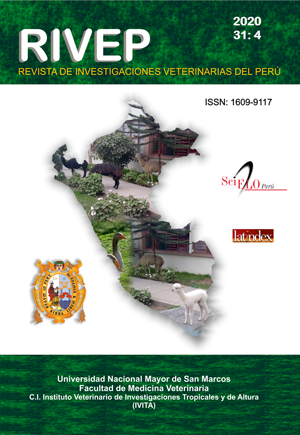Evaluation of caprine eimeriasis in four districts of the department of Ica, Peru
DOI:
https://doi.org/10.15381/rivep.v31i4.19021Keywords:
goats, coccidiosis, Humay, Independencia, El Carmen, Chincha BajaAbstract
This study aimed to estimate the prevalence of eimerias in creole goats from four districts of the department of Ica, Peru, as well as to identify the species of eimerias present and to determine the frequency according to the variables origin, age group and sex. Faecal samples (n=728) were collected between July and August 2017. Samples were processed using the qualitative flotation technique with Sheather's solution and quantitative by the modified McMaster method. The species were identified by measuring sporulated oocysts and by morphological characteristics. The prevalence of eimerias was 99.2%, with no significant differences due to age, sex and origin. The average parasite load was 2158 opg, considered as low load. Eight species of eimerias were identified in goats, E. caprina, E. caprovina, E. ninakohlyakimovae, E. arloingi, E. apsheronica, E. jolchijevi, E. alijevi and E. christenseni, being the highest frequency of E. caprovina, E. caprina and E. ninakohlyakimovae (32, 26 and 23% respectively).
Downloads
Downloads
Published
Issue
Section
License
Copyright (c) 2020 Ruth Terrones V., Amanda Chávez V., Rosa Pinedo V.

This work is licensed under a Creative Commons Attribution-NonCommercial-ShareAlike 4.0 International License.
AUTHORS RETAIN THEIR RIGHTS:
a. Authors retain their trade mark rights and patent, and also on any process or procedure described in the article.
b. Authors retain their right to share, copy, distribute, perform and publicly communicate their article (eg, to place their article in an institutional repository or publish it in a book), with an acknowledgment of its initial publication in the Revista de Investigaciones Veterinarias del Perú (RIVEP).
c. Authors retain theirs right to make a subsequent publication of their work, to use the article or any part thereof (eg a compilation of his papers, lecture notes, thesis, or a book), always indicating the source of publication (the originator of the work, journal, volume, number and date).



